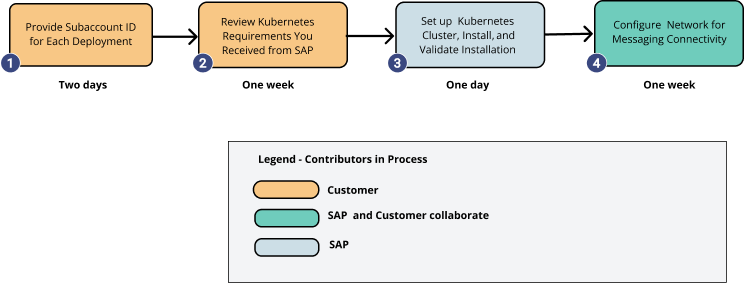Process to Deploy SAP Integration Suite, Advanced Event Mesh in a Dedicated Region
After your initial overview meeting with SAP about installing and deploying
Prerequisites
Before starting this process, ensure that you have:
- Access to your account in advanced event mesh. This access is provided to you as part of a Welcome letter that you receive when you purchase advanced event mesh.
- Received and reviewed the requirements for the Dedicated Region. These requirements are determined by the technical staff at SAP based on the Dedicated Region Questionnaire you completed when you requested your deployment.
Deployment Steps
To deploy a Dedicated Region, you complete a four-step process with the expected timelines as shown in the following diagram . The timelines are based on typical conditions and good coordination between the SAP and your organization.

Step 4 establishes Messaging Connectivity and doesn’t impact the installation of the deployment of advanced event mesh (Mission Control Agent). This advanced configuration may require multiple levels of approval from your organization’s security and IT teams. Therefore, we recommend that you start this configuration as early as possible.
The four steps in the process include:
-
Provide a Subaccount ID for Each Deployment
On SAP BTP (Business Technology Platform), you must create a subaccount. The identifier for the subaccount (or SubAccount ID) is required to start the process for each deployment in a Dedicated Region. Each subaccount ID maps to a Kubernetes cluster (or Dedicated Region). For this reason, even if you have an existing Kubernetes cluster in the same region (or datacenter), you must provide a new subaccount to start this process to create another Kubernetes cluster. For more information about subaccounts, see Account Model.
Expected Timeframe for Completion: Two days1
-
Review the Kubernetes Cluster and Dedicated Region Requirements
SAP sends the details of the Dedicated Region and the installation of advanced event mesh that will be completed for you. You must review these requirements and confirm that they are correct. These requirements result from the collaboration between SAP and your technical stakeholders, and are also based on your completed questionnaires. These requirements define:
-
the region and architectural details of the Kubernetes cluster in the Dedicated Region
-
network details, such as addresses and ports that must be configured to allow connectivity to various components of your deployment
-
As part of the review, you must confirm:
- of the maximum event broker services that are created in the Kubernetes
- the CIDR size fits into your network plan based on the CIDR calculators
- the networking options that you want to use
Expected Timeframe for Completion: One week1
-
-
Set Up and Validate the Kubernetes Cluster, and Install Advanced Event Mesh for the Dedicated Region
For a Dedicated Region, SAP sets up the requested Kubernetes cluster and region based on your requirements. SAP validates the operational and management connectivity is correct. In addition, SAP installs the Mission Control Agent and deploys advanced event mesh to the region and verifies an event broker service can be created.
Expected Timeframe for Completion: One day2
-
Configure Network for Messaging Connectivity Between Your applications and the Dedicated Region
You must configure the network connectivity between your client messaging applications and your Dedicated Region. This advanced configuration may require multiple levels of approval from your organization’s security and IT teams. Therefore, we recommend that you start this configuration as early as possible.
Expected Timeframe for Completion: One week 3
1 The timeframe is an estimate based on previous Dedicated Region deployments and is dependent on the customer completing the action. Timeframes above the estimates are often due to customer-based delays.
2 The timeframe is an estimate based on previous Dedicated Region deployments.
3 The timeframe is a best-case estimate based on previous deployments and does not include the time elapsed for approvals within your organization. It's important for you to recognize that the timeframe is an estimate that is subject to the completion of necessary approvals and the availability of both parties to collaborate. If you require a networking configuration that requires multiple levels of approval in from the customer's security and IT teams, this timeframe may be extended.